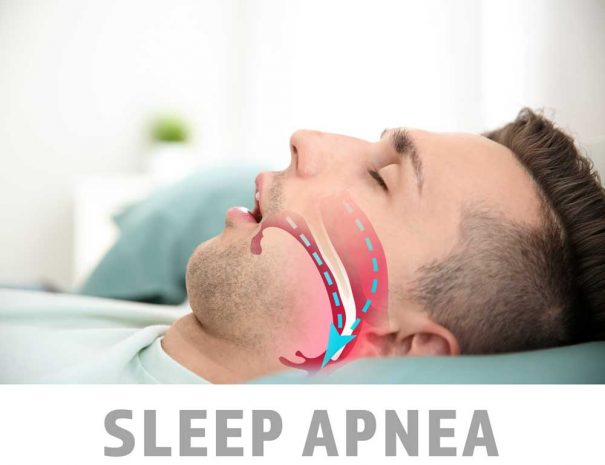Sleep Apnea
Could it be sleep apnea that’s stealing the energy and vitality from your days?
Frequently Asked Questions About Sleep Apnea
Apnea literally means “no breath” or “stopping breathing”. When you have sleep apnea, there’s a restriction in your upper respiratory tract that restricts airflow to your lungs for 10 seconds or longer – that is, you actually stop breathing.
This makes your blood oxygen level drop which in turn triggers your brain to wake you up just enough to take a breath. These small ‘micro arousals’ interrupt the sleep cycle causing unrefreshed sleep.
This can happen many many times every hour and you may not even know it. As you can imagine, constantly being triggered back into breathing, hour after hour, night after night, can put a strain on your body and your overall health. The next day you may feel tired and wrung out. Sleep apnea isn’t just an inconvenience. Left undiagnosed and untreated, it can have serious long-term effects on your health.
It’s so common! 3 in 10 men and almost 1 in 5 women have sleep apnea.
There are two main causes of sleep apnea. Airway obstruction or a disconnect between your brain and your lungs. Obstruction is the most common type.
When you fall asleep your throat and tongue muscles can relax and this can cause the soft tissue in your mouth and throat to fall back and obstructive your airway.
After about 10 seconds you brain detects a problem and and triggers you to wake up to breathe.
The main causes of obstructive sleep apnea are.
- Sleeping on your back – If you sleep on your back, the relaxed muscles in your mouth and tongue can restrict your breathing
- Thick tissues at the back of your mouth – A piece of tissue called an ‘uvula’ hangs down from the top of your mouth. When you go to sleep it can slip back and obstruct your breathing
- Enlarged tonsils and adenoids – large glands at the back of your throat can narrow the airway.
- If you’re overtired – or suffering from lack of sleep, when you do finally sleep, your muscles relax more and this can contribute to obstructive sleep apnea
- Allergies, hayfever, colds, sinus infections and flu – can block your nasal passages and contribute to sleep apnea.
- Overweight – people often carry extra fatty tissue in and around their neck area. This increase can contribute to the increase in airway restriction.
Has someone told you that you snore loudly or sometimes gasp for breath while you sleep? Maybe they’ve noticed that you seem to stop breathing from time to time in your sleep. These are classic signs and symptoms of obstructive sleep apnea.
Because it happens when you’re asleep, you may have sleep apnea without knowing. If you have central sleep apnea, you may not snore at all, and you will need to rely on other signs and symptoms to alert you to the problem.
Sleep apnea symptoms include.
- Snoring
- Gasping for breathe or paused breathing during sleep
- Restless sleep or insomnia
- Frequently going to the toilet at night
- Waking up with night sweats
- Waking up with a dry or sore throat
- Morning headaches
- Feeling constantly tired throughout the day
- Trouble concentrating and remembering things
- Impotence and lack of sex drive
- Mood swings
- Weight gain
- High blood pressure
Treating sleep apnea can help you regain the restful, refreshing sleep you’ve been missing out on. With effective sleep apnea treatment, you can look forward to more peaceful nights as well as awakening with more energy to face the day.
Here’s a list of how to treat sleep apnea.
- CPAP – CPAP stands for ‘continuous positive airway pressure’. CPAP therapy is the gold standard for treating sleep apnea. It’s a device that delivers a constant flow of air via a mask while you sleep, preventing your airway from becoming blocked and enabling you to sleep peacefully and awaken refreshed.
- Weight loss / lifestyle changes – Sleep apnea can cause you to gain weight which can in turn worsen the degree of sleep apnea. Losing weight can help with the sleep apnea. Quitting smoking and reducing alcohol intake can also help reduce sleep apnea.
- Positional Therapy – some people only suffer from sleep apnea when they sleep on their back. There are devices that can insure you only sleep on your side.
- Mandibular Therapy – A specially designed custom mouthguard may work as an alternative to CPAP therapy. These devices keep your jaw from falling back and obstructing the airway.
- Surgery – If CPAP and/or mandibular therapy haven’t worked for you, one or more invasive surgical options can be performed as a sleep apnea treatment. Your surgeon may recommend one or more of these as a last resort. Some of the surgical names include, somnoplasty, sinus surgery, tonsillectomy, laser treatment.

